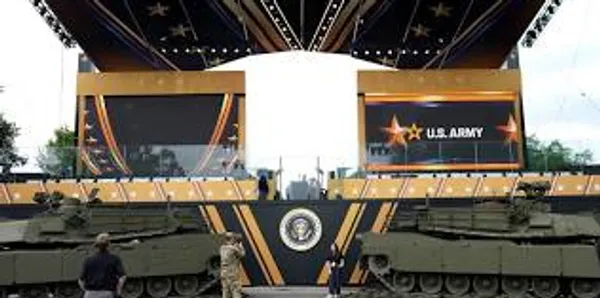Trump Presides Over Massive Military Parade in D.C.
By: Ark-La-Tex Staff Writer
On his 79th birthday and the 250th anniversary of the U.S. Army, President Donald Trump presided over a massive military parade in Washington, D.C., marking a rare and grand display of American military power. The event, held on Flag Day, brought thousands to the capital for what was both a patriotic celebration and a moment of political contention.
The parade, the first of its kind in the capital since 1991, featured approximately 6,500 soldiers, around 150 military vehicles including tanks and armored personnel carriers, and about 50 aircraft such as Black Hawks, Apaches, and fighter jets. Spectators were treated to scenes of mounted cavalry, Revolutionary War reenactors, and a 21-gun salute. Military bands, flyovers by iconic aircraft, and fireworks rounded out the celebration. A public reenlistment ceremony added a solemn yet stirring dimension. President Trump addressed the crowd with patriotic fervor, declaring the U.S. Army “the greatest, fiercest and bravest fighting force ever.” Organizers estimated the cost of the event between $25 million and $45 million. To prevent damage to the city’s infrastructure, protective steel plates and rubber pads were deployed under heavy equipment.
Though Trump avoided overt political statements, the parade fulfilled a long-standing desire of his to stage a show of American strength similar to those in other countries. “Every other country celebrates their victories. It's about time America did too,” he said during his speech. Among the crowd were military families, Trump supporters, and tourists who traveled from across the country. Dan and Deb Funk from Nebraska described the event as “a beautiful expression of American pride.”
But not all shared that sentiment. While some hailed the parade as a unifying tribute to the armed forces, others criticized it as excessive and politically motivated. D.C. Delegate Eleanor Holmes Norton likened it to the “performative military parades in the style of authoritarian leaders,” while editorial voices in The Washington Post and The Wall Street Journal noted the blend of celebration and political signaling. Questions were also raised about the cost and allocation of military resources. Republican Senators Roger Wicker and Susan Collins questioned the parade’s financial burden, and Democrats like Richard Blumenthal and Tammy Duckworth argued those funds would have been better spent on improving conditions for military families and readiness training.
As the capital reveled in the parade, a wave of protests swept across the country under the slogan “No Kings.” More than 2,000 cities participated in the decentralized demonstrations organized by the 50501 Movement, with support from organizations like the ACLU. Marchers in cities such as New York, Los Angeles, Seattle, Denver, and Philadelphia called for democratic accountability and voiced concern about what they see as creeping authoritarianism. A giant balloon of Trump seated on a golden toilet floated over downtown Los Angeles, where clashes with police briefly turned tense as authorities deployed tear gas and flash-bangs. In anticipation of unrest, some states activated the National Guard, although the protests remained largely peaceful. Organizers deliberately avoided Washington, D.C., to prevent direct confrontation with parade-goers.
The simultaneous celebration and protest laid bare the sharp divide within the nation. Both political parties voiced support for honoring the military, but their views diverged significantly over the motivations and symbolism behind the parade. As jet engines roared over the National Mall and military bands marched in step, thousands of voices across the country marched in protest, demonstrating that in a deeply polarized America, even a tribute to the troops can become a reflection of broader national tensions.
